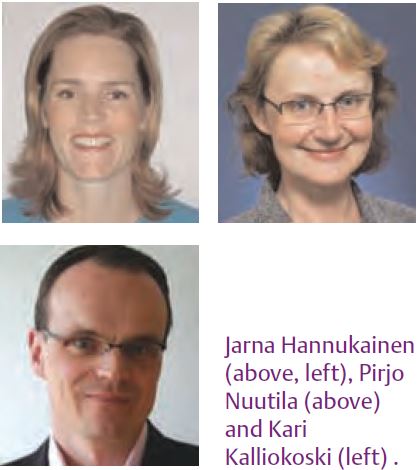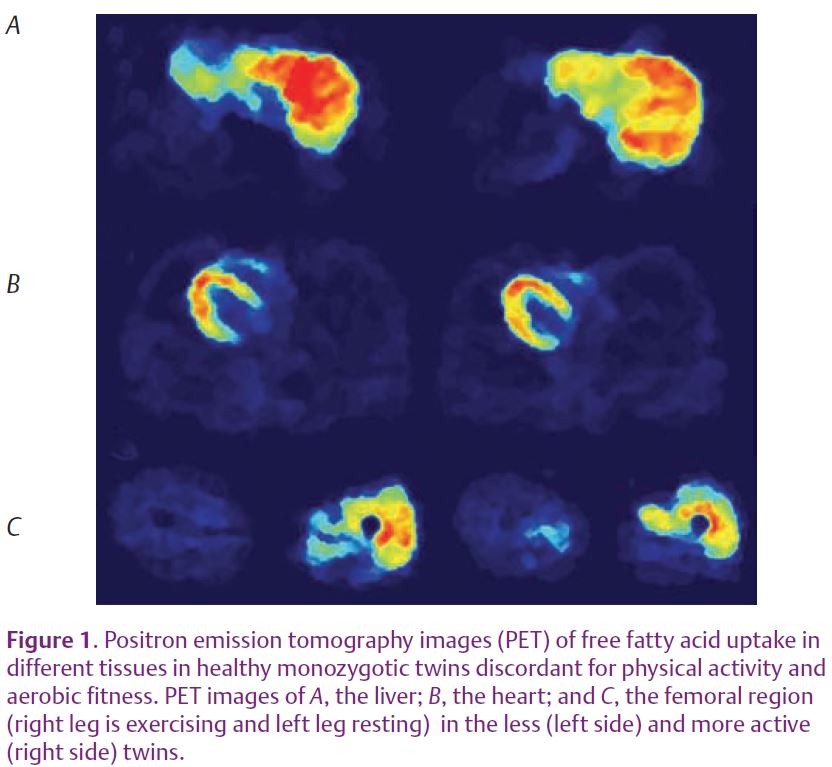
Physiology News Magazine
Exercise for liver health
Sedentary life-style, together with irregular rhythm of life and high energy diet, are nightmares to social and financial policymakers today
Features
Exercise for liver health
Sedentary life-style, together with irregular rhythm of life and high energy diet, are nightmares to social and financial policymakers today
Features
Jarna Hannukainen, Pirjo Nuutila , & Kari Kalliokoski
Turku PET Centre, University of Turku, Turku, Finland
https://doi.org/10.36866/pn.71.29

Physical inactivity simultaneously with increased body adiposity are significant risk factors for the development of metabolic syndrome, i.e. hypertension, type 2 diabetes and cardiovascular diseases which are today the leading causes of death especially in industrialized countries. This ticking time bomb has awakened physicians and authorities to write exercise prescriptions and underline the importance of physically active life-style and keep-fit training. Regular exercise training, in its different forms, is achievable for everyone, cheap, and an effective health preventor when performed regularly.
Abnormalities in lipid metabolism are usually among the first symptoms expressing unhealthy way of life. Impaired free fatty acid (FFA) metabolism is associated with reduced lipid oxidation and increased body adiposity. Impaired lipid oxidation leads to a higher concentration of circulating FFAs in the blood and a higher FFA supply for tissue uptake. Increased tissue FFA uptake, especially in the skeletal muscle and liver, inhibits the glucose metabolism and further creates a predisposition for impaired glucose tolerance (Arner, 2002).
Regular exercise training is known to improve impaired glucose tolerance and lipid metabolism. Although the positive effects of increased physical activity on FFA metabolism are well known in metabolic disorders, the results in skeletal muscle (Jansson & Kaijser, 1987; Turcotte et al. 1992; Bergman et al. 1999) and myocardium (Heiss et al. 1976; Turpeinen et al. 1996) in healthy young adults are contradictory. This inconsistency in study results may partly be explained by the different methods and physio-logical state used. To our knowledge no previous investigations studying the effects of exercise training on hepatic FFA uptake exists.
The liver is one of the most versatile and important internal organ in the body. It transforms food to nutrients, maintains normal blood glucose concentration, acts as a buffer against toxic substances, storages and releases nutrients and vitamins, and excretes hormones. In a fasting state, liver mainly utilizes FFAs and amino acids as fuels. In the whole body lipid metabolism liver converts carbohydrates into FFAs, consumes, stores, and releases lipids as part of lipoproteins and thus, controls blood lipid levels. As whole body lipid metabolism is linked to hepatic function, impaired lipid metabolism i.e. increased concentration of circu-lating FFA increases hepatic lipid accumulation and further hepatic insulin resistance and type 2 diabetes.
Studies investigating the effect of physical activity on liver in general are rare and the effects of physical activity on hepatic FFA uptake are largely unknown. In rats and elderly humans exercise training has been shown to increase liver oxidative metabolism (Mauriz et al. 2000). In rats, exercise training has been suggested to reduce liver triglyceride production and in rats and humans to increase high density lipoprotein cholesterol production (Gorski et al. 1990; Ghanbari-Niaki et al. 2007). Interestingly, exercise training has also been shown to change hepatic gene expression. In obese mice model exercise training normalized 38 of the 62 hepatic gene transcripts altered due to high fat diet. These included hepatic genes which relate to tissue defense or detoxification (Lee et al. 2006).
Exercise training-induced enhance-ment in insulin sensitivity has been previously shown to be due to improvements in peripheral insulin sensitivity. However, increased body adiposity with increased circulation of FFA and triacylglycerol in muscle and liver ensue insulin resistance in both of these tissues. Recently it was shown that exercise training also improves hepatic insulin sensitivity in sedentary men due to endogenous hepatic glucose production (Shojaee-Moradie et al. 2007).
An increased circulation of FFA predispose to hepatic fat accumula-tion and the pathogenesis of non-alcoholic fatty liver disease (NAFLD) which may lead to significant liver-related morbidity and mortality. At the moment no established therapy for NAFLD exists and current treat-ment relies on life-style modifica-tions, i.e. reducing metabolic risk factors by weight loss through diet and regular exercise training (Mishra & Younossi, 2007). Recently physically active lifestyle was found to associate with lower intrahepatic fat content in healthy humans (Perseghin et al. 2007).

We have been interested on hepatic function and the effects of physically active lifestyle on liver metabolism. We are especially interested to know which are the specific mechanisms how exercise training influence on hepatic FFA uptake. Is the positive influence of exercise just secondary via decreased body adiposity? Or does exercise training also have primary effects on tissue FFA uptake?In our recent study we investigated the effect of moderately increased physical activity and fitness on tissue FFA uptake with healthy non-obese young adult male monozygotic twins discordant for physical activity and aerobic fitness (Hannukainen et al. 2007). Using positron emission tomography and [18F]FTHA we found that hepatic FFA uptake was ~30 %lower in the more active compared to the less active group (Fig. 1). However, hepatic FFA uptake was not associated with the amount of physical activity or with fitness state, but correlated significantly with the whole-body fat percentage. Although both the more and less active twins had normal weight, the more active twins had 10 % lower whole-body fat percentage. This was mainly due to the lower amount of abdominal subcutaneous fat, although the difference in visceral fat mass between groups was statistically more significant. When the difference in the whole body fat percentage was taken into account in statistical analyses (ANCOVA), the difference in hepatic FFA uptake between the groups decreased (p = 0.08) suggesting that hepatic FFA uptake is at least partly influenced by body adiposity. The lower hepatic FFA uptake in the more active twins is in agreement with the suggestion that with decreased body adiposity, especially in the intra-abdominal area, the rate of adipose tissue lipolysis is lower, thus decreasing the FFA load to the liver (Arner, 2002).
Although hepatic FFA uptake was lower in the more active twins, we did not found any differences in myocardial or skeletal muscle FFA uptake at rest or during exercise between the groups. Thus, as the liver is the most versatile organ and covers most of its energy demand by oxidizing FFA, it is reasonable to presume that it is more sensitive to even small changes in the availability of substrates compared to skeletal muscle and the myocardium.
It is very likely that physically active lifestyle is a significant preventor for hepatic fat accumulation. However, at the moment no exercise training intervention exists to prove this assumption, which is mostly due to limited availability of appropriate study methods. Thus, intervention studies are needed to prove the positive influences of exercise training on liver health.
References
Arner P (2002). Insulin resistance in type 2 diabetes: role of fatty acids. Diabetes Metab Res Rev 18 Suppl 2, S5-S9.
Bergman BC, Butterfield GE, Wolfel EE, Casazza GA, Lopaschuk GD & Brooks GA (1999). Evaluation of exercise and training on muscle lipid metabolism. Am J Physiol 276, E106-E117.
Ghanbari-Niaki A, Khabazian BM, Hossaini-Kakhak SA, Rahbarizadeh F & Hedayati M (2007). Treadmill exercise enhances ABCA1 expression in rat liver. Biochem. Biophys Res Commun. 361, 841-846.
Gorski J, Oscai LB & Palme WK (1990). Hepatic Lipid-Metabolism in Exercise and Training. Medicine and Science in Sports and Exercise 22, 213-221.
Hannukainen JC, Nuutila P, Ronald B, Kaprio J, Kujala UM, Janatuinen T, Heinonen PJ, Kapanen J, Viljanen T, Haaparanta M, Rönnemaa T, Parkkola R,k Knuuti J & Kalliokoski KK (2007). Increased physical activity decreases hepatic free fatty acid uptake: a study in human monozygotic twins. J Physiol 578, 347-358.
Heiss HW, Barmeyer J, Wink K, Hell G, Cerny FJ, Keul J & Reindell H (1976). Studies on the regulation of myocardial blood flow in man. I: Training effects on blood flow and metabolism of the healthy heart at rest and during standardized heavy exercise. Basic Res Cardiol 71, 658-675.
Jansson E & Kaijser L (1987). Substrate utilization and enzymes in skeletal-muscle of extremely endurance-trained men. J Appl Physiol 62, 999-1005.
Lee KY, Kim SJ, Cha YS, So JR, Park JS, Kang KS & Chon TW (2006). Effect of exercise on hepatic gene expression in an obese mouse model using cDNA microarrays. Obesity 14, 1294-1302.
Mauriz JL, Tabernero B, Garcia-Lopez J, Jorquera F, Villa JG & Gonzalez-Gallego J (2000). Physical exercise and improvement of liver oxidative metabolism in the elderly. Eur J Appl Physiol 81, 62-66.
Mishra P & Younossi ZM (2007). Current treatment strategies for non-alcoholic fatty liver disease (NAFLD). Curr Drug Discov Technol 4, 133-140.
Perseghin G, Lattuada G, De Cobelli F, Ragogna F, Ntali G, Esposito A, Belloni E, Canu T, Terruzzi I, Scifo P, Del Maschio A & Luzi L (2007). Habitual physical activity is associated with intrahepatic fat content in humans. Diabetes Care 30, 683-688.
Shojaee-Moradie F, Baynes KC, Pentecost C, Bell JD, Thomas EL, Jackson NC, Stolinski M, Whyte M, Lovell D, Bowes SB, Gibney J, Jones RH & Umpleby AM (2007). Exercise training reduces fatty acid availability and improves the insulin sensitivity of glucose metabolism. Diabetologia 50, 404-413.
Turcotte LP, Richter EA & Kiens B (1992). Increased plasma FFA uptake and oxidation during prolonged exercise in trained vs. untrained humans. Am J Physiol 262, E791-E799.
Turpeinen AK, Kuikka JT, Vanninen E, Vainio P, Vanninen R, Litmanen H, Koivist VA, Bergström K & Uusitupa MI (1996). Athletic heart: a metabolic, anatomical, and functional study. Med Sci Sports Exerc 28, 33-40.
